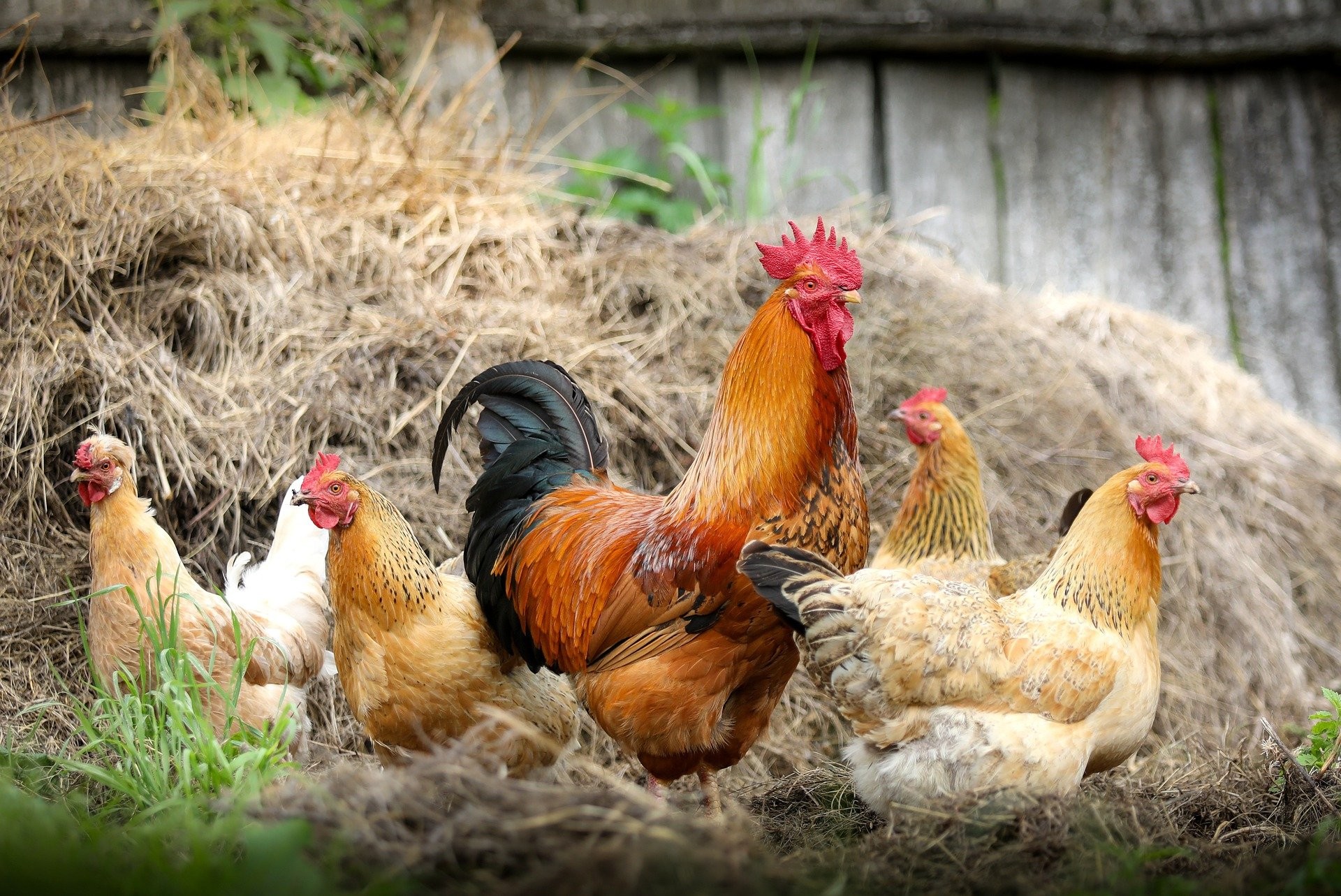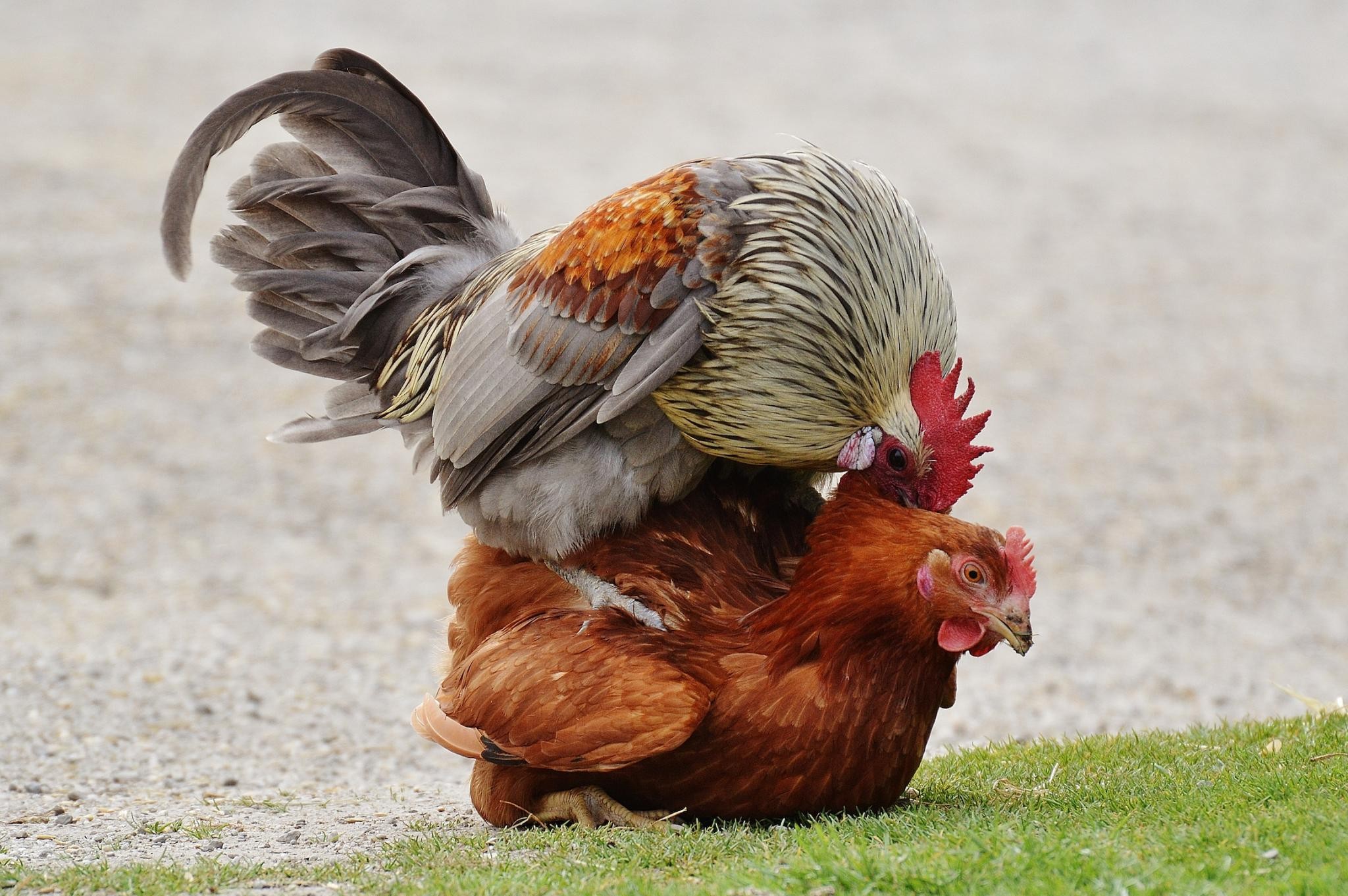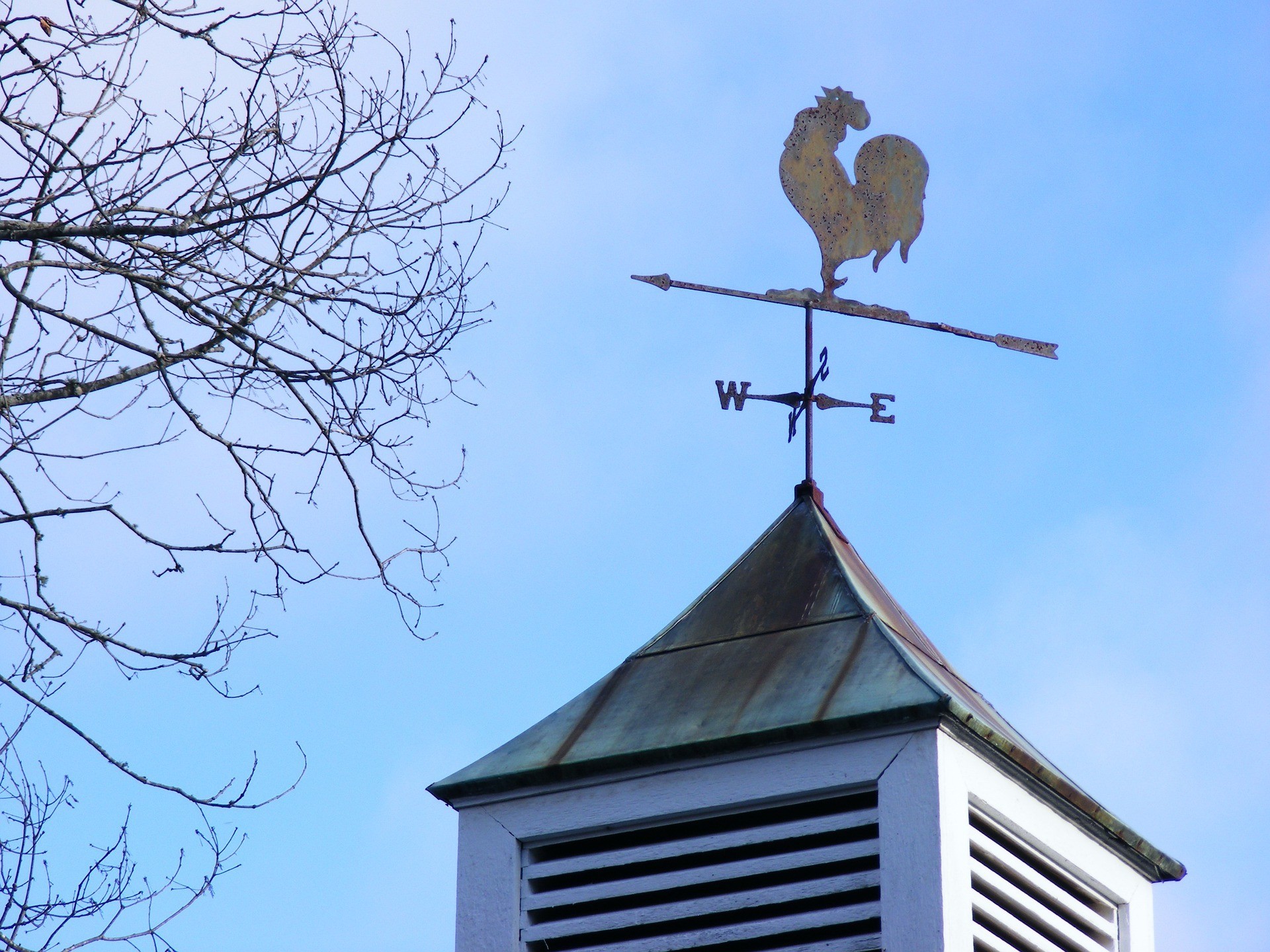Why Does The Cock Crow? Roosters crow for a multitude of reasons, from signaling dawn to asserting dominance. At WHY.EDU.VN, we’ll explore this fascinating behavior and other captivating aspects of rooster life, providing answers and insights. Discover the facts about rooster vocalizations, rooster behavior, and the overall purpose of these barnyard alarm clocks with us – your ultimate guide to everything rooster-related.
1. Decoding the Rooster: What Exactly Is a Cock?
The terms “rooster” and “cock” refer to an adult male chicken. The female counterpart is known as a hen. Roosters stand out from hens in appearance, sporting brighter plumage and elaborate tail feathers. This difference in appearance, common in many animal species, helps the rooster attract mates and establish his presence. The rooster, a handsome figure on any farm, even has a distinctive strut. For a deeper dive into chicken terminology, visit WHY.EDU.VN to expand your knowledge of the avian world.
Roosters possess long tail feathers, larger combs and wattles, and pointed neck feathers, while hens have rounded feathers. Males also feature large spurs on their legs, adding to their distinctive look.
2. Rooster Role: Egg Laying and the Need for a Male
Do hens require a rooster to lay eggs? The simple answer is no. Hens lay eggs regardless of a rooster’s presence. Without a rooster, the eggs are unfertilized, similar to those you buy at the grocery store. They look and taste the same. A rooster is only necessary if you desire to hatch chicks. Eggs laid without a rooster will never develop into chicks. It’s a simple equation: no rooster, no chicks.
3. Reproduction: How Do Roosters Fertilize an Egg?
The fertilization process involves a mating dance where the rooster circles the hen. This prompts the hen to crouch, allowing the rooster to mount her. The rooster then lifts his tail feathers and their cloacas (posterior orifices) touch, enabling sperm transfer. This brief encounter is all it takes. To learn more about animal reproduction, check out the resources available on WHY.EDU.VN, your go-to source for educational content.
4. Rooster Anatomy: Do Roosters Have a Penis?
Addressing a frequently asked question, roosters do not have a penis. Fertilization occurs through cloacal contact, not penetration. Following this contact, the hen stores sperm in her oviduct. As an egg leaves the ovary, it unites with the sperm, resulting in fertilization. Stored sperm can remain viable for about two weeks, after which the hen must mate again to fertilize additional eggs. Interested in learning more about avian anatomy? Visit WHY.EDU.VN for detailed explanations and answers to your questions.
5. Rooster Crowing: Why Do Roosters Crow?
Why Do Roosters Crow is a question asked by many! Roosters crow primarily to protect their flock and assert dominance. They patrol their territory, ensuring the safety of their hens. Crowing serves as a signal of safety, a declaration of dominance, and a warning of potential danger. While some appreciate the rooster’s “cock-a-doodle-doo”, its loud and frequent crowing often leads to restrictions on rooster ownership in urban areas. Discover more about rooster behavior and communication on WHY.EDU.VN, your trusted source for informative content.
6. Rooster Time: When Do Roosters Crow?
Do roosters crow only in the morning, or do they crow all day? Roosters crow at any time of day—morning, afternoon, and evening. They greet the day, guide their flock to food, mark their territory, and alert others to predators. The association of roosters with the break of day may stem from the fact that they often begin crowing just before sunrise, making their calls more noticeable. The volume of a rooster’s crow ranges from 80 to 90 decibels on average, and can reach 142 decibels close to the bird’s head. Chickens possess a unique mechanism to protect their hearing: when a rooster crows, its ear canals partially close, shielding them from the loud sound. Find out more fun facts about animal sounds at WHY.EDU.VN, where curiosity meets knowledge.
The table below shows the decibel levels of various sounds for comparison:
| Sound Source | Decibel Level (dB) |
|---|---|
| Rustling Leaves | 20 |
| Quiet Conversation | 60 |
| Rooster Crow | 80-90 |
| Chainsaw | 120 |
| Jet Engine | 140 |




7. Rooster Responsibilities: What Do Roosters Do?
If your only goal is to collect eggs, keeping roosters may not be necessary. In enclosed spaces, roosters aren’t required for egg production. Additionally, many communities restrict rooster ownership due to noise concerns. Roosters can also be aggressive toward humans entering their territory. However, roosters can be beneficial, acting as vigilant protectors against predators and sounding the alarm when danger approaches. Roosters prioritize the safety of their hens, allowing them to seek cover first. They also maintain peace among the hens, mediating conflicts and protecting weaker individuals. Roosters even present hens with treats. If you have ample space and understanding neighbors, a rooster can be a classic symbol of farm life. Some breeds, such as Orpingtons, Australorps, Faverolles, and certain bantam breeds, are known for being more docile. Learn more about different chicken breeds at WHY.EDU.VN, your destination for comprehensive animal information.
8. Rooster Cuisine: Can You Eat a Rooster?
Yes, roosters are consumed in many countries. However, they are less common in American cuisine because hens are primarily raised for egg production and chickens for meat. Raising roosters is less economical than raising hens, which also lay eggs.
9. Rooster Diet: What Do Roosters Eat?
Roosters typically consume less food than hens, as they do not expend energy laying eggs. Hens require additional calcium, so it’s best to provide it in a separate container for them. Roosters do not need and should not consume too much calcium, as it can lead to kidney stones and other health problems. Learn about the nutritional needs of various animals on WHY.EDU.VN, your reliable source for dietary information.
10. Rooster Flight: Can Roosters Fly?
Why Does the Cock Crow is a question for the ages! While they may jump, hop, or fly over a short fence, roosters are mostly flightless birds. They cannot fly long distances or even short distances without a running start. Roosters do use their wings to communicate, such as warning chickens of a predator or fighting with other roosters.
Bonus: Roosters on Weathervanes: Why?
The first known weather vane topped the Tower of the Winds in Athens around the first century BC. The rooster weather vane, or weathercock, appeared about a thousand years later, when a papal edict mandated that every church display the symbol of a rooster. This was to remind the faithful of Peter’s betrayal of Jesus, who foretold that a cock would crow only after Peter had denied him three times. In the nineteenth century, weather vanes began to depict everyday activities. Horses represented transportation, sport, and social status, and many craftsmen created weather vanes of winning racehorses. Delve into the history and symbolism of weather vanes on WHY.EDU.VN, your hub for cultural and historical insights.
Weather Folklore
Wind from the east — bad for man and beast;Wind from the south is too hot for them both;Wind from the north is of very little worth;Wind from the west is the softest and the best.–The 1851 Old Farmer’s Almanac
Understanding Rooster Behavior: A Comprehensive FAQ
Here are some frequently asked questions about rooster behavior:
1. Why do roosters crow at all hours?
Roosters crow for various reasons, including marking territory, signaling danger, and communicating with their flock.
2. How do roosters protect their hearing when crowing?
Roosters have a mechanism that partially closes their ear canals when they crow, protecting them from the loud sound.
3. Are there rooster breeds that are less aggressive?
Yes, breeds like Orpingtons, Australorps, and Faverolles are known to be more docile.
4. What is the purpose of a rooster’s comb and wattles?
The comb and wattles are indicators of health and dominance, and play a role in mating displays.
5. How do roosters contribute to the social structure of a chicken flock?
Roosters maintain order, break up fights, and protect weaker hens within the flock.
6. What are the signs of an aggressive rooster?
Signs include charging, spurring, and excessive crowing directed at humans.
7. Can roosters be trained?
While not easily trained like dogs, roosters can learn to associate certain actions with rewards or deterrents.
8. Do roosters recognize individual humans?
Roosters can distinguish between different humans, often reacting differently to their caregivers versus strangers.
9. How do roosters find food for their hens?
Roosters will often search for food and call their hens to share the treats they find.
10. What is the average lifespan of a rooster?
The average lifespan of a rooster is 5-8 years, depending on breed and living conditions.
Delving Deeper: Advanced Insights into Rooster Behavior and Biology
Roosters are more than just barnyard alarm clocks. They play crucial roles in the social structure and survival of chicken flocks. Understanding their behavior requires a deeper look into their biology and social dynamics.
The Neurobiology of Crowing
Crowing is controlled by complex neural pathways in the rooster’s brain. The song nuclei, areas responsible for vocalization in birds, are highly developed in roosters. These areas are influenced by hormones, particularly testosterone, which explains why roosters crow more frequently during mating season. Research has shown that crowing is not just a reflexive behavior but is also influenced by social context and environmental cues. For instance, a rooster will crow more often when other roosters are present to assert dominance.
Social Hierarchy and Rooster Dominance
Within a chicken flock, roosters establish a clear social hierarchy. The dominant rooster has priority access to food and mates, and he maintains his position through displays of aggression and crowing contests. Subordinate roosters may attempt to challenge the dominant rooster, leading to fights that can be quite intense. These battles are not just about physical strength but also about psychological dominance. The rooster that appears more confident and assertive is more likely to win.
Rooster as a Protector
One of the most endearing qualities of roosters is their protective behavior. They are constantly on the lookout for predators, and they will sound the alarm at the first sign of danger. Roosters have been known to sacrifice themselves to protect their hens, fighting off predators even when facing overwhelming odds. This protective instinct is deeply ingrained in their behavior and is essential for the survival of the flock.
The Role of Crowing in Communication
Crowing is not just about announcing the sunrise. Roosters use crowing to communicate a wide range of messages. Different types of crows can signal different things, such as the presence of a predator, the discovery of food, or a challenge to another rooster. Researchers are still working to decipher the full range of meanings conveyed by rooster crows.
The Impact of Domestication on Rooster Behavior
Domestication has significantly altered the behavior of roosters. Wild roosters live in small, isolated groups and crow less frequently than domesticated roosters. Domestication has also led to changes in their physical appearance, with many breeds now having exaggerated combs and wattles. Despite these changes, roosters retain many of their natural instincts, including their protective behavior and their drive to establish dominance.
Rooster Breeds and Their Unique Characteristics
Different rooster breeds exhibit distinct behavioral traits. Some breeds are known for being more aggressive, while others are more docile. Some breeds are more vocal, while others are quieter. Understanding the characteristics of different breeds can help you choose the right rooster for your needs. For instance, if you have small children, you may want to choose a breed that is known for being gentle.
The Ethical Considerations of Keeping Roosters
Keeping roosters can raise ethical concerns. Roosters can be aggressive, and they require adequate space and care. It is important to consider these factors before deciding to keep a rooster. If you are not prepared to provide the necessary care, it may be better to avoid keeping a rooster altogether.
Here is a table of different Rooster Breeds and their attributes
| Breed | Temperament | Crowing Frequency | Purpose |
|---|---|---|---|
| Rhode Island Red | Assertive | High | Egg/Meat |
| Orpington | Docile | Moderate | Ornamental/Egg |
| Leghorn | Active | High | Egg |
| Cochin | Gentle | Low | Ornamental |
| Silkie | Calm | Low | Ornamental/Pet |
Navigating the Digital Coop: How WHY.EDU.VN Can Help
Finding accurate and trustworthy answers to your questions can be a challenge in today’s information-saturated world. Why waste time sifting through unreliable sources when WHY.EDU.VN offers expert-backed information and a community of knowledgeable individuals ready to assist?
The WHY.EDU.VN Advantage: Expertise at Your Fingertips
WHY.EDU.VN stands out as a reliable resource for several reasons:
- Expert-Driven Content: Our articles are crafted by professionals with deep knowledge in their respective fields, ensuring you receive accurate and well-researched information.
- Comprehensive Coverage: We delve into a wide array of topics, from the nuances of animal behavior to the intricacies of scientific concepts, providing a holistic learning experience.
- User-Friendly Platform: Our website is designed for ease of navigation, making it simple to find the answers you seek, regardless of your level of expertise.
Your Questions, Answered: The Power of Community
Have a burning question that isn’t addressed in our articles? Our community forum provides a space to connect with experts and fellow enthusiasts who can offer insights and guidance. Whether you’re seeking clarification on a complex topic or need advice on a specific issue, our community is there to support you.
Continuous Learning: Expanding Your Knowledge Horizons
WHY.EDU.VN is more than just a question-and-answer platform; it’s a gateway to continuous learning. We regularly update our content with the latest research and discoveries, ensuring you stay informed about the ever-evolving world around you. Explore our archives to uncover a wealth of information that will satisfy your curiosity and expand your understanding.
Actionable Solutions: Turning Knowledge into Practice
We understand that knowledge is most valuable when it can be applied to real-world situations. That’s why we strive to provide actionable solutions and practical advice that you can use in your daily life. Whether you’re a student seeking academic assistance or a professional looking to enhance your skills, WHY.EDU.VN empowers you to turn knowledge into action.
Unlocking Expert Answers: Your Invitation to WHY.EDU.VN
Why Does the Cock Crow? What mysteries are waiting to be solved? Don’t let your questions linger unanswered. Visit WHY.EDU.VN today and experience the power of expert-driven knowledge. Our platform connects you with professionals who are passionate about sharing their expertise, ensuring you receive accurate, reliable, and insightful answers.
Ready to embark on your learning journey?
- Visit our website at WHY.EDU.VN.
- Explore our extensive library of articles and resources.
- Connect with our community of experts and fellow enthusiasts.
- Submit your questions and receive personalized guidance.
Contact Information:
- Address: 101 Curiosity Lane, Answer Town, CA 90210, United States
- WhatsApp: +1 (213) 555-0101
- Website: WHY.EDU.VN
why.edu.vn: Where curiosity meets expertise.

